Nicola Cornick's Blog, page 30
May 31, 2011
There's lots going on!
I'm so excited about all my website updates for June! Not only is there a new excerpt from Notorious up on the site but there is also a very special contest to celebrate the upcoming  publication of the book. I thought it would be a cute idea to have a Notorious-themed competition so I am offering a bottle of the Ralph Lauren perfume of the same name, which is described as having notes of "blackcurrant, pink peppercorn, bergamot, chocolate cosmos, white frost peonies, carnation, patchouli, musk, vanilla and iris," and being for "the sexy, daring and confident female." I'm also offering a DVD of the film Heartbreaker, in honour of my heroine, Susanna, and her unusual profession. Heartbreaker is a funny, romantic and very cute film. Oh, and there is a set of the first three Scandalous Women books to be won as well!
publication of the book. I thought it would be a cute idea to have a Notorious-themed competition so I am offering a bottle of the Ralph Lauren perfume of the same name, which is described as having notes of "blackcurrant, pink peppercorn, bergamot, chocolate cosmos, white frost peonies, carnation, patchouli, musk, vanilla and iris," and being for "the sexy, daring and confident female." I'm also offering a DVD of the film Heartbreaker, in honour of my heroine, Susanna, and her unusual profession. Heartbreaker is a funny, romantic and very cute film. Oh, and there is a set of the first three Scandalous Women books to be won as well!
Meanwhile, over on the UK pages you can catch up with the launch of the Scandalous Women of the Ton books in the UK. I'll be doing a number of radio and newspaper interviews and I'm going to be talking at the Burford Festival on June 17th and the Witney Book Festival on June 19th. If you are in the area please drop by to say hello! I would love to see you. I'll be posting more information here on the blog, Facebook and Twitter as the Scandalous Women hit the UK shops!
And please do keep an eye on the blog where I love to chat to everyone. I'll be posting more historical articles and blog contests this month.
Thank you for dropping by and thank you, as ever, for writing to me and reading my books and encouraging me to keep on writing! Love from Nicola.
©2011 Nicola Cornick. All Rights Reserved.
.May 30, 2011
Quirky History!
Today I'm sharing a little bit of quirky history, which as you know, is the sort I love!
This memorial is called "Deadman's Plack" and it lies in the middle of what is left of Harewood Forest in Hampshire. It commemorates the murder in 963 of Earl Ethelwold, a Saxon  noble, by King Edgar. Edgar was the great-grandson of Alfred the Great and was known as "Edgar the Peaceful," something of a misnomer for a man renowned for his personal violence. He was the first king to rule a consolidated England in the sense that he was ruler over the three major Anglo-Saxon kingdoms of Northumbria, Mercia and Wessex (which still leaves a fair percentage of England out of the equation). He is also credited with introducing important legal and religious reform into England.
noble, by King Edgar. Edgar was the great-grandson of Alfred the Great and was known as "Edgar the Peaceful," something of a misnomer for a man renowned for his personal violence. He was the first king to rule a consolidated England in the sense that he was ruler over the three major Anglo-Saxon kingdoms of Northumbria, Mercia and Wessex (which still leaves a fair percentage of England out of the equation). He is also credited with introducing important legal and religious reform into England.
So far, so good, but Edgar also had an eye for the ladies and a bad temper. He married at sixteen but then took a shine to a nun, Wulfrith, whom he kidnapped, seduced and made his mistress. After the death of his first wife, Edgar's fancy then fell on Elfrith, whom he had heard was very beautiful. He sent his friend, Earl Ethelwold, to check her out. Elfrith was indeed a stunner and Ethelwold married her from under the king's nose, then reported back that she was actually rather ugly. Edgar smelled a rat, discovered what Ethelwold had done and killed him with a javelin in the back when they were out hunting in Harewood Forest. He married Elfrith soon after.
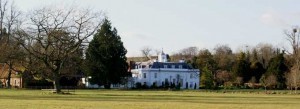 The monument was erected in 1825 by Lieutenant Colonel William Iremonger of Wherwell Priory who was the owner of Harewood Forest in the Regency period. A plaque in gothic lettering on the side of the monument tells the story of Edgar's murderous deed. This is the quirky bit for me – that Iremonger, who fought under Wellington in the Peninsular Wars, should be so taken with a tale hundreds of years old that he erected a monument in memory of a Saxon Earl.
The monument was erected in 1825 by Lieutenant Colonel William Iremonger of Wherwell Priory who was the owner of Harewood Forest in the Regency period. A plaque in gothic lettering on the side of the monument tells the story of Edgar's murderous deed. This is the quirky bit for me – that Iremonger, who fought under Wellington in the Peninsular Wars, should be so taken with a tale hundreds of years old that he erected a monument in memory of a Saxon Earl.
©2011 Nicola Cornick. All Rights Reserved.
.May 27, 2011
"Peculiar to the female sex…"
In 1798 Benjamin Rush wrote the first "scientific" analysis of phobias when he identified 18 specific phobias, some of which were satirical. He wrote: "The insect phobia. This disease is  peculiar to the female sex. A spider, a flea, or a musqueto (sic) alighting upon a lady's neck has often produced an hysterical fit…" Okay, I put my hand up. I wouldn't like a musqueto alighting on my neck – for good reason since we know they can carry malaria – although I don't think I would become hysterical over it. And I have seen grown men reduced to gibbering wrecks by some insects. But leaving aside Mr Rush's bias, I think a historical look at phobias is really interesting. Maybe that's just because I sometimes suffer from claustrophobia and a darkened, enclosed space can induce a panic attack in me. I've often thought that throughout history people must have responded to their fears in exactly the same way that we do now and I wondered how they referred to it and what, if anything, were the treatments for it.
peculiar to the female sex. A spider, a flea, or a musqueto (sic) alighting upon a lady's neck has often produced an hysterical fit…" Okay, I put my hand up. I wouldn't like a musqueto alighting on my neck – for good reason since we know they can carry malaria – although I don't think I would become hysterical over it. And I have seen grown men reduced to gibbering wrecks by some insects. But leaving aside Mr Rush's bias, I think a historical look at phobias is really interesting. Maybe that's just because I sometimes suffer from claustrophobia and a darkened, enclosed space can induce a panic attack in me. I've often thought that throughout history people must have responded to their fears in exactly the same way that we do now and I wondered how they referred to it and what, if anything, were the treatments for it.
 The word phobia comes from the Greek meaning panic, fear, terror and flight. The God Phobos was honoured for provoking fear and flight in the Greeks' enemies. Until the mid-nineteenth century the word "phobia" was only used in the sense of "hydrophobia" which was a term for Rabies. It was another 75 years before the word "phobia" was attached to a set of diagnostic criteria and came to mean: "A persistent, abnormal and irrational fear of a situation or thing that compels one to avoid it despite the awareness and reassurance that it is not dangerous." Early accounts of phobias arise in medical and philosophical writings from the Ancient Greek and Roman periods. Hippocrates recorded the case of a man taken by an irrational terror when he heard the sound of a flute at a banquet in the evenings. He was fine if he heard a flute during the day but not at night. Hippocrates also mentioned a man with a fear of heights and another with a cat phobia. Hippocrates put these fears down to "melancholia," suffering from an excess of black bile, which was one of the three major types of insanity. Later physicians also attributed phobias to this melancholy over-heating of the brain and the belief persisted well into the 18th century. I couldn't find much reference to treatments other than blood-letting but in one case the treatment for Hydrophobia was to throw the patient into a water tank when he was off his guard! If he could swim (which presumably they wouldn't find out until he was in there) then he should be pushed under; if he couldn't swim he should be allowed to sink underwater and then fished out. There is no record of this treatment being successful…
The word phobia comes from the Greek meaning panic, fear, terror and flight. The God Phobos was honoured for provoking fear and flight in the Greeks' enemies. Until the mid-nineteenth century the word "phobia" was only used in the sense of "hydrophobia" which was a term for Rabies. It was another 75 years before the word "phobia" was attached to a set of diagnostic criteria and came to mean: "A persistent, abnormal and irrational fear of a situation or thing that compels one to avoid it despite the awareness and reassurance that it is not dangerous." Early accounts of phobias arise in medical and philosophical writings from the Ancient Greek and Roman periods. Hippocrates recorded the case of a man taken by an irrational terror when he heard the sound of a flute at a banquet in the evenings. He was fine if he heard a flute during the day but not at night. Hippocrates also mentioned a man with a fear of heights and another with a cat phobia. Hippocrates put these fears down to "melancholia," suffering from an excess of black bile, which was one of the three major types of insanity. Later physicians also attributed phobias to this melancholy over-heating of the brain and the belief persisted well into the 18th century. I couldn't find much reference to treatments other than blood-letting but in one case the treatment for Hydrophobia was to throw the patient into a water tank when he was off his guard! If he could swim (which presumably they wouldn't find out until he was in there) then he should be pushed under; if he couldn't swim he should be allowed to sink underwater and then fished out. There is no record of this treatment being successful…
In the intervening time from the Ancient World to the late 18th century references to phobias mainly occur in theological texts. During this period they were seen as manifestations of  evil spirits and sufferers were sometimes subject to exorcism as a cure. Two very specific phobias recorded were Plague Phobia in the late 16th and early 17th century and Syphilophobia (fear of syphilis) in the 17th and 18th centuries. Both of these seem entirely understandable phobias to develop. In 1650 Descartes wrote about phobias to objects as diverse as roses and cats, and Shakespeare described animal phobia in The Merchant of Venice: "Some men there are that love on a gaping pig; Some that are mad when they behod a cat…" (Cats seem to feature large in historical phobias).
evil spirits and sufferers were sometimes subject to exorcism as a cure. Two very specific phobias recorded were Plague Phobia in the late 16th and early 17th century and Syphilophobia (fear of syphilis) in the 17th and 18th centuries. Both of these seem entirely understandable phobias to develop. In 1650 Descartes wrote about phobias to objects as diverse as roses and cats, and Shakespeare described animal phobia in The Merchant of Venice: "Some men there are that love on a gaping pig; Some that are mad when they behod a cat…" (Cats seem to feature large in historical phobias).
During the 18th and 19th centuries there were several attempts to understand and classify phobias in a medical context. Pinel called it "mania without delirium." Esquirol called it "emotional delirium." Theories on the cause of phobias varied from stomach ailments to a poor upbringing. In 1872 a seminal work about agoraphobia referred to three male patients with the following symptoms: "impossibility of walking through certain streets or squares, or possibility of so doing only with resultant dread of anxiety…" So it wasn't just women who suffered from phobias. Of course not. But during the Victorian period particularly there was a cultural approach to seeing women as "hysterics" who needed to be treated with drugs, or sex, or who, in the worst examples, were locked up in an asylum because they were categorised as "mad" simply because they had a certain phobia.
Do you suffer from a phobia? I drew on my own experience of claustrophobia when I was writing Mistress by Midnight in which Merryn and Garrick are trapped in a fallen building during the London Beer Flood.
©2011 Nicola Cornick. All Rights Reserved.
.May 25, 2011
It's the Word Wench Birthday Party!
The Word Wenches are five years old and we are celebrating today with a big party on the blog. There's a fun contest and big book giveaway. Above all this is an opportunity to say 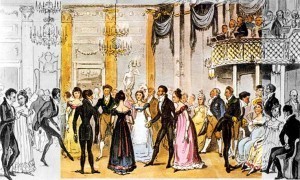 thank you to our loyal readers and friends, to welcome new ones and to have a bit of fun! So please come along and join us! The party's here!
thank you to our loyal readers and friends, to welcome new ones and to have a bit of fun! So please come along and join us! The party's here!
©2011 Nicola Cornick. All Rights Reserved.
.May 24, 2011
This is what a romantic novelist looks like
No – that's not what a romantic novelist looks like (now that really would be newsworthy.) That is the sad puppy who visits the blog whenever the media kicks my beloved romantic fiction.  Actually he doesn't come out as often as that. Poor little thing, he'd be making more appearance than the Queen if he did. (And doesn't she do well for her age? It's amazing!) Which brings me rather neatly to the latest controversy in the romance community.
Actually he doesn't come out as often as that. Poor little thing, he'd be making more appearance than the Queen if he did. (And doesn't she do well for her age? It's amazing!) Which brings me rather neatly to the latest controversy in the romance community.
There has been quite a fuss over the last few days about an article in the Daily Mail stereotyping the members of the Romantic Novelists' Association as old ladies with blue rinses and support stockings who gleefully write about sex to top up their pensions. I'm generalising here (it's catching!) but that was the main slant of the item. Anyway, I'm not going into detail about the article since others have commented on it with great wit and articulacy, and to be honest I can't bear to give it any more air time than it has already had. (Yes, I know, I've already done that.) The first thing I wanted to say though is that there is nothing unusual to me about older ladies with or without blue rinses, writing hot sex if they choose to do so. Heck, there's nothing unusual in older ladies parachuting, or driving to Victoria Falls in a camper van, or playing the harp if they choose to do so. We're all people and we all have a wide range of interests and activities. Why do we have to be pigeonholed by age? I'm all for celebrating the achievements of anyone from cradle to grave. Let's just take the age element out of it.
 The problem is, as ever, in the stereotyping. We're all familiar with journalists falling back on lazy cliches about romance writing. There have been some great articles written about romance but they tend to get overshadowed by pieces like this one, because of course controversy sells newspapers. Another aspect of this particular piece that leaves a bad taste in the mouth is the sight of a female journalist writing an article that patronises other female writers. Kate Walker blogs about that very eloquently here. And then there is the sex aspect – no, not the older ladies writing it, but the fact that as Julie Cohen points out here, the elderly male writer doesn't generally get dissected for his fashion choices. Especially if he writes literary fiction. And so the wheel turns back to the prejudices about romantic fiction.
The problem is, as ever, in the stereotyping. We're all familiar with journalists falling back on lazy cliches about romance writing. There have been some great articles written about romance but they tend to get overshadowed by pieces like this one, because of course controversy sells newspapers. Another aspect of this particular piece that leaves a bad taste in the mouth is the sight of a female journalist writing an article that patronises other female writers. Kate Walker blogs about that very eloquently here. And then there is the sex aspect – no, not the older ladies writing it, but the fact that as Julie Cohen points out here, the elderly male writer doesn't generally get dissected for his fashion choices. Especially if he writes literary fiction. And so the wheel turns back to the prejudices about romantic fiction.
Anyway, let's turn to something more positive. Because out of this comes Kate Johnson's fabulous idea for romance authors to post photographs of  ourselves to show just who we are in all our variety and splendour. Bravo Kate! So here I am. This is what this romantic novelist looks like.
ourselves to show just who we are in all our variety and splendour. Bravo Kate! So here I am. This is what this romantic novelist looks like.
©2011 Nicola Cornick. All Rights Reserved.
.May 20, 2011
Notorious Giveaway!
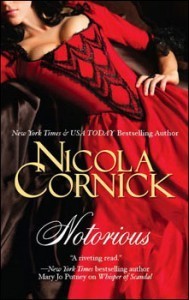 That's a giveaway of an advance copy of Notorious, not a notorious giveaway!
That's a giveaway of an advance copy of Notorious, not a notorious giveaway!
Over on the Word Wenches today I am blogging about travel in the Regency period and am offering a copy of Notorious to one commenter, so please come over and join the discussion!
I hope you all have a very Happy Weekend! I am going to Stratford on Avon to the theatre and am very excited!
©2011 Nicola Cornick. All Rights Reserved.
.May 18, 2011
The Gentleman Scientist
I first became aware of the work of Andrew Crosse when I visited Fyne Court in Somerset a couple of weeks ago. He was a Regency "gentleman scientist" who was an early pioneer in the  experimentation and use of electricity. He was a child prodigy who had mastered Ancient Greek by the age of eight and then became obsessed with scientific development. As the son of a wealthy family he was fortunate that he had the means to indulge his obsession.
experimentation and use of electricity. He was a child prodigy who had mastered Ancient Greek by the age of eight and then became obsessed with scientific development. As the son of a wealthy family he was fortunate that he had the means to indulge his obsession.
Crosse first developed a fascination with electricity when he went to a lecture on it at Oxford. His early experiments with it involved giving electric shocks to unsuspecting friends (one assumes the friendships if not the friends did not always survive!) When he returned from his studies at Oxford to run the estate at Fyne Court, Crosse's interest in experimenting intensified. He strung up a third of a mile of copper wire in the grounds of the house and connected it to equipment in the music room. Voltage would build up when there was a fog, heavy rain or thunder and lightning. Conducting equipment would begin sparking and flashing and explosions would shake the music room. Local people assumed Crosse was trying to attract storms and he became known as the "Wizard of Broomfield." Another of Crosse's experiments proved even more controversial. When he put volcanic rock into acid and passed an electric current through it to generate crystals, Crosse found that insects began appearing from out of the stone. When this was reported in the local newspapers, Crosse was accused of trying to play God by creating life. It is also claimed that Crosse's lecture on this experiment, which was attended by Percy and Mary Shelley, was the inspiration for Mary's novel Frankenstein.
 Crosse was something of a polymath as he was also a poet who took his inspiration from the Somerset Quantock hills. He was reputedly a friend of both Wordsworth and Coleridge who visited Fyne Court to discuss poetry with him. On a personal level, Crosse married twice, the second time amid some scandal. His first wife was Mary Ann Hamilton with whom he had seven children. After her death and that of his brother, both in 1846, Crosse was stricken with grief and left Fyne Court, and the house and estate fell into disrepair. Three years later, however, he met his second wife, the beautiful Cornelia Berkeley, who was forty three years his junior and a mere twenty two years old when they married. They went on to have three children of their own and Cornelia recorded Crosse's life and work in two volumes "Red Letter Days of my Life" and "Memorials Scientific and Literary of Andrew Crosse the Electrician" (which sounds a little odd to our ears as the word electrician in those days was used to denote someone at the cutting edge of scientific experimentation). Crosse left Fyne Court and his fortune to Cornelia in a will made on his deathbed, and left the organ in the music room to his eldest son, John. Cornelia, however, promptly handed over the estate to John.
Crosse was something of a polymath as he was also a poet who took his inspiration from the Somerset Quantock hills. He was reputedly a friend of both Wordsworth and Coleridge who visited Fyne Court to discuss poetry with him. On a personal level, Crosse married twice, the second time amid some scandal. His first wife was Mary Ann Hamilton with whom he had seven children. After her death and that of his brother, both in 1846, Crosse was stricken with grief and left Fyne Court, and the house and estate fell into disrepair. Three years later, however, he met his second wife, the beautiful Cornelia Berkeley, who was forty three years his junior and a mere twenty two years old when they married. They went on to have three children of their own and Cornelia recorded Crosse's life and work in two volumes "Red Letter Days of my Life" and "Memorials Scientific and Literary of Andrew Crosse the Electrician" (which sounds a little odd to our ears as the word electrician in those days was used to denote someone at the cutting edge of scientific experimentation). Crosse left Fyne Court and his fortune to Cornelia in a will made on his deathbed, and left the organ in the music room to his eldest son, John. Cornelia, however, promptly handed over the estate to John.
Andrew was not the only member of the Crosse family with a scandalous reputation. He introduced his eldest son John to Byron's daughter Ada, Countess  of Lovelace (pictured right). The two, who were both married to other people, embarked on an affair that was apparently fuelled by a mutual love of gambling. Ada lost enormous sums of money at the gambling table and John sold the family jewels to pay her debts. What John's wife and indeed his step-mother thought of this is not recorded but perhaps Andrew Crosse had been on to something when he had left his son nothing but the…um… organ in his will.
of Lovelace (pictured right). The two, who were both married to other people, embarked on an affair that was apparently fuelled by a mutual love of gambling. Ada lost enormous sums of money at the gambling table and John sold the family jewels to pay her debts. What John's wife and indeed his step-mother thought of this is not recorded but perhaps Andrew Crosse had been on to something when he had left his son nothing but the…um… organ in his will.
The house at Fyne Court is no longer standing as it was destroyed by fire in 1894 when one of the servants lit a candle to warm her metal hair curling tongs and forgot to blow it out when she left the house. The candle set fire to the curtains, dressing table and floor and from there it raged out of control. A message was sent to Taunton for the fire engine but it took several hours for the fire brigade to arrive because of the steep hills along the route. At various points the crew had to get out and push the engine. Desperate attempts were made to save family portraits, china and furniture. All the books from the library were thrown out onto the lawn in case the library and music room burned. The central part of the house collapsed. Although a claim for insurance eventually paid out £4000, which in the late Victorian period would have been enough to rebuild the house, it was never reconstructed. The remaining buildings are however open to the public and can be visited. In the Information Centre you can learn more about Crosse and his work. There was wonderful walks around the grounds. And the cafe serves delicious cake!
©2011 Nicola Cornick. All Rights Reserved.
.May 16, 2011
Prizes and Puddings!
Happy Monday! First up, I'd like to congratulate Quilt Lady, who has won a backlist book for commenting on my weekend blog post! Quilt Lady, please get in touch at ncornick(at) madasafish.com and let me know which book you would like! Meanwhile I'm still looking for Bobby and HJ and Jennifer L to get in touch to claim their prizes too!
madasafish.com and let me know which book you would like! Meanwhile I'm still looking for Bobby and HJ and Jennifer L to get in touch to claim their prizes too!
Now onto the Historical Recipe of the Week! I've got a sweet tooth this week, so here is a recipe for 17th century Lemon Drizzle Cake. You'll need an 8 x 6 loaf tin for this one.
Ingredients: 5 oz self raising flour, 5oz plain flour, 7oz unsalted butter (softened), 7oz caster sugar, 4 beaten eggs (medium sized), the zest of two lemons and 2 tablespoons of lemon juice.
To make the syrup glaze you will need another 2 tablespoons of lemon juice and 3oz caster sugar.
Oven temperature: 140 degrees C, 300 degrees F, Gas Mark 2
Method: Grease and line the cake tin. Sieve the flours together. Beat together the butter and sugar until it is light and fluffy. Beat the eggs into the butter and sugar mixture a little at a time. Fold in the flour. Stir in the lemon zest and lemon juice. Spoon the mixture into the tin and bake for and hour and 15 minutes.
While the cake is baking, make the syrup glaze. Sieve the lemon juice into a small pan and add the sugar, stirring all the time. Heat gently until the sugar dissolves and then remove the pan from the heat. When the cake is ready, drizzle the lemon mixture over the top and leave to cool before removing it from the tin.
Then – eat it and enjoy!
I have noticed that a lot of my historical recipes are puddings and cakes. Hmm. I'll try to find a savoury recipe next time!
©2011 Nicola Cornick. All Rights Reserved.
.May 12, 2011
The "Lost" Prologue to Mistress By Midnight
It's a feature of my writing that I cut almost as much from a book as I leave in. Sometimes I'll write a scene and then take it out, knowing immediately that it doesn't work. Sometimes it  will get sacrificed at the revision stage when I realise that much as I want to keep a particular scene in, I know in my heart of hearts that it has to go. Perhaps it's too long and needs to be cut down, or it's in the wrong place, or it's totally superfluous because I've already covered that ground, or it simply doesn't move the story on. Very occasionally a scene will get as far as my editor who will say: "It's great, but… " But it has to go. And it will end up in the Big File of Lost Scenes.
will get sacrificed at the revision stage when I realise that much as I want to keep a particular scene in, I know in my heart of hearts that it has to go. Perhaps it's too long and needs to be cut down, or it's in the wrong place, or it's totally superfluous because I've already covered that ground, or it simply doesn't move the story on. Very occasionally a scene will get as far as my editor who will say: "It's great, but… " But it has to go. And it will end up in the Big File of Lost Scenes.
I suspect an awful lost of authors have their equivalent of my Big File of Lost Scenes, those pieces of writing that you adore and can hardly bring yourself to cut out of your manuscript even though you know the book will be better without them. I transfer them carefully to a document called Spares, or perhaps Spares 2 or Spares 3, or even Extras or Bits to Include. You can see how organised my filing system is. And I promise myself that I will one day get them out and dust them down and use them in a different book. I never do. Perhaps I should. There might be some useful stuff in there.
 The lost prologue to Mistress By Midnight was different. It was a whole prologue. It kicked off the story. (Of course it did – it was a prologue). I loved it. It was also a scene that had appeared in a different book, One Wicked Sin, but this time it was written from Merryn's perspective not Lottie's, which was a fun thing to do. When my editor pointed out that the book started in the wrong place I could have cried but I knew she was right. So the prologue had to go and the story started a year later with Merryn hiding under Garrick's bed instead of meeting him at a masquerade ball. But if you would like to read how Merryn and Garrick met in a different universe, the lost prologue to Mistress By Midnight is here.
The lost prologue to Mistress By Midnight was different. It was a whole prologue. It kicked off the story. (Of course it did – it was a prologue). I loved it. It was also a scene that had appeared in a different book, One Wicked Sin, but this time it was written from Merryn's perspective not Lottie's, which was a fun thing to do. When my editor pointed out that the book started in the wrong place I could have cried but I knew she was right. So the prologue had to go and the story started a year later with Merryn hiding under Garrick's bed instead of meeting him at a masquerade ball. But if you would like to read how Merryn and Garrick met in a different universe, the lost prologue to Mistress By Midnight is here.
If you're an author, how do you feel about cutting scenes you love? And do you ever use them elsewhere? And as a reader do you enjoy reading the same scene – or even the same book – from a different character's perspective? Do you think it can add something to a story or is it just going over old ground? I'm offering a backlist book of your choice to one commenter.
I'm also still looking for some previous blog prize winners to unite them with their prizes – Bobby, HJ, and Jennifer L please get in touch!
©2011 Nicola Cornick. All Rights Reserved.
.May 11, 2011
The Folly on the Hill!
A couple of months ago I wrote on the Word Wenches blog about the romantic ruins at Old Wardour Castle which were part of a picturesque 18th century landscape. At that time I had  no idea that I would have the chance to stay in an 18th century pavilion that was at one time a part of such a romantic landscape garden. But last week I travelled to Halswell in Somerset where I stayed in a folly called "Robin Hood's Hut" which was originally a gothic hermitage designed to entertain the guests at Halswell Hall as part of a romantic garden design.
no idea that I would have the chance to stay in an 18th century pavilion that was at one time a part of such a romantic landscape garden. But last week I travelled to Halswell in Somerset where I stayed in a folly called "Robin Hood's Hut" which was originally a gothic hermitage designed to entertain the guests at Halswell Hall as part of a romantic garden design.
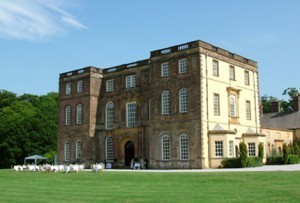 Robin Hood's Hut was built by Sir Charles Kemeys Tynte in the late 1760s. Sir Charles shared a passion for creating picturesque landscapes with two good friends, Henry Hoare II of Stourhead and Copplestone Warre Bampfylde of Hestercombe (And isn't that the most fabulous name for a historical character that you could ever come across?) Whilst Stourhead and Hestercombe have been restored to their former glories, Halswell sadly has not and a great deal of the Georgian pleasure garden that Sir Charles created has been lost, overgrown or decayed. Originally it contained a number of natural features designed to stimulate and enhance visitors' emotions. In a belt of woodland known as Mill Wood, Sir Charles created a series of linked ponds with a Bath Stone Bridge and a Druid's Temple. Nearer Halswell House itself were several more structures including a stepped pyramid, a small rotunda, a rockwork screen and a memorial to a favourite horse. You can find out more about them here on the wonderful Halswell website.
Robin Hood's Hut was built by Sir Charles Kemeys Tynte in the late 1760s. Sir Charles shared a passion for creating picturesque landscapes with two good friends, Henry Hoare II of Stourhead and Copplestone Warre Bampfylde of Hestercombe (And isn't that the most fabulous name for a historical character that you could ever come across?) Whilst Stourhead and Hestercombe have been restored to their former glories, Halswell sadly has not and a great deal of the Georgian pleasure garden that Sir Charles created has been lost, overgrown or decayed. Originally it contained a number of natural features designed to stimulate and enhance visitors' emotions. In a belt of woodland known as Mill Wood, Sir Charles created a series of linked ponds with a Bath Stone Bridge and a Druid's Temple. Nearer Halswell House itself were several more structures including a stepped pyramid, a small rotunda, a rockwork screen and a memorial to a favourite horse. You can find out more about them here on the wonderful Halswell website.
At the foot of the hill, Sir Charles built the Temple of Harmony, a replica of the 1st Century BC Temple of Fortuna Virilis in Rome. Robin Hood's Hut was built around the same time. It was designed to be part of the view from the gardens but also to be visited and to be a lookout point. The curious name comes from the fact that in the 18th century Robin and the ancient English liberties he defended were very fashionable and popular. Plus the "hut" stands on the edge of a wood and is a rustic thatched sort of a dwelling.
Approaching it we drove through the wood and came upon the house from behind, just as Sir Charles' guests would have done in their carriages. To their eyes it was intended to  appear romantically gothic, suggestive of hermits and witches to an 18th-century sensibility. I have to admit that with the wood pressing close at the back and with the huge entrance door leading into a dark and gloomy space, it was rather spooky. (I know I'm not selling this as a place to stay!) However, when you throw open the front doors and step out under the elegant canopy (called an umbrello in correct terminology) the view is absolutely stunning.
appear romantically gothic, suggestive of hermits and witches to an 18th-century sensibility. I have to admit that with the wood pressing close at the back and with the huge entrance door leading into a dark and gloomy space, it was rather spooky. (I know I'm not selling this as a place to stay!) However, when you throw open the front doors and step out under the elegant canopy (called an umbrello in correct terminology) the view is absolutely stunning.
 In Sir Charles' time the visitors would have been invited to admire the view and would then have retired to the elegant 'china room' to the right of the front door. Refreshments would have been provided by servants from the little kitchen on the other side, which could only be entered from the outside. This room is now the bedroom and the remains of the range are still there. The servants were not to be distracted by the view and so the north window was blocked up. The China Room, though, is a delightful place to sit, read, drink tea and enjoy the view on the days when it is too windy or cold to be out under the umbrello.
In Sir Charles' time the visitors would have been invited to admire the view and would then have retired to the elegant 'china room' to the right of the front door. Refreshments would have been provided by servants from the little kitchen on the other side, which could only be entered from the outside. This room is now the bedroom and the remains of the range are still there. The servants were not to be distracted by the view and so the north window was blocked up. The China Room, though, is a delightful place to sit, read, drink tea and enjoy the view on the days when it is too windy or cold to be out under the umbrello.
Robin Hood's Hut was restored by the Landmark Trust, who also have many other fine, elegant and exciting historical buildings available to stay in. (We stayed once at Frenchman's 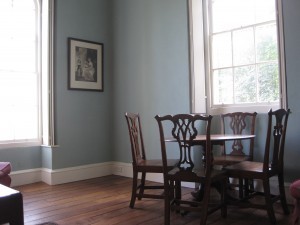 Creek of Daphne Du Maurier fame!) One word of warning, though. In order not to spoil the architectural integrity of Robin Hood's Hut the Landmark Trust decided to install a bathroom outside, a few feet away from the main pavilion. In the daytime this is fine but you need a brave spirit, a torch, a quick sprint and possibly a raincoat if you decide to visit the bathroom at night!
Creek of Daphne Du Maurier fame!) One word of warning, though. In order not to spoil the architectural integrity of Robin Hood's Hut the Landmark Trust decided to install a bathroom outside, a few feet away from the main pavilion. In the daytime this is fine but you need a brave spirit, a torch, a quick sprint and possibly a raincoat if you decide to visit the bathroom at night!
So what do you think? Do you fancy a stay in the hermit's house or would the thought of the dash to the bathroom be too much for you? Do you like the idea of staying in old buildings ot do you prefer all mod cons?
©2011 Nicola Cornick. All Rights Reserved.
.


